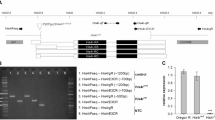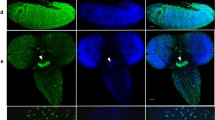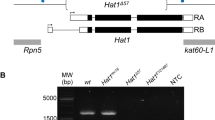Abstract
One way in which a distinct chromosomal domain could be established to carry out a specialized function is by the localized incorporation of specific histone variants into nucleosomes. H2AZ, one such variant of the histone protein H2A, is required for the survival of Drosophila melanogaster1, Tetrahymena thermophila2 and mice (R. Faast et al., in preparation). To search for the unique features of Drosophila H2AZ (His2AvD, also referred to as H2AvD) that are required for its essential function, we have performed amino-acid swap experiments in which residues unique to Drosophila His2AvD were replaced with equivalently positioned Drosophila H2A.1 residues. Mutated His2AvD genes encoding modified versions of this histone were transformed into Drosophila and tested for their ability to rescue null-mutant lethality. We show that the unique feature of His2AvD does not reside in its histone fold but in its carboxy-terminal domain. This C-terminal region maps to a short α-helix in H2A that is buried deep inside the nucleosome core.
This is a preview of subscription content, access via your institution
Access options
Subscribe to this journal
Receive 51 print issues and online access
$199.00 per year
only $3.90 per issue
Buy this article
- Purchase on Springer Link
- Instant access to full article PDF
Prices may be subject to local taxes which are calculated during checkout



Similar content being viewed by others
References
van Daal, A. & Elgin, S. C. R. Ahistone variant, H2AvD, is essential in Drosophila melanogaster . Mol. Biol. Cell 3, 593–602 (1992).
Liu, X., Li, B. & Gorovsky, M. A. Essential and nonessential histone H2A variants in Tetrahymena thermophila . Mol. Cell. Biol. 16, 4305–4311 (1996).
Luger, K., Mader, A. W., Richmond, R. K., Sargent, D. F. & Richmond, T. J. Crystal structure of the nucleosome core particle at 2.8 A resolution. Nature 389, 251–260 (1997).
Hecht, A., Laroche, T., Strahl-Bolsinger, S., Gasser, S. M. & Grunsteine, M. Histone H3 and H4N-termini interact with SIR 3 and SIR 4 proteins: a molecular model for the formation of heterochromatin in yeast. Cell 80, 583–592 (1995).
Peterson, C. L. & Tamkun, J. W. The SWI-SNF complex: a chromatin remodeling machine? Trends Biochem. Sci. 20, 143–146 (1995).
Ng, K. W., Ridgway, P., Cohen, D. R. & Tremethick, D. J. The binding of a Fos/Jun heterodimer can completely disrupt the structure of a nucleosome. EMBO J. 16, 2072–2085 (1997).
Rubin, G. M. & Spradling, A. C. Genetic transformation of Drosophila with transposable element vectors. Science 218, 348–353 (1982).
Spradling, A. C. & Rubin, G. M. Transposition of cloned P-elements into Drosophila germ line chromosomes. Science 218, 341–347 (1982).
Acknowledgements
We thank R. King and J. A. Lake for help in constructing mutants M5, M6, M7 and CT.
Author information
Authors and Affiliations
Corresponding authors
Rights and permissions
About this article
Cite this article
Clarkson, M., Wells, J., Gibson, F. et al. Regions of variant histone His2AvD required for Drosophila development. Nature 399, 694–697 (1999). https://doi.org/10.1038/21436
Received:
Accepted:
Issue Date:
DOI: https://doi.org/10.1038/21436
This article is cited by
-
Over-expression of ANP32E is associated with poor prognosis of pancreatic cancer and promotes cell proliferation and migration through regulating β-catenin
BMC Cancer (2020)
-
Genome-wide identification of histone H2A and histone variant H2A.Z-interacting proteins by bPPI-seq
Cell Research (2017)
-
Molecular basis and specificity of H2A.Z–H2B recognition and deposition by the histone chaperone YL1
Nature Structural & Molecular Biology (2016)
-
Histone storage and deposition in the early Drosophila embryo
Chromosoma (2015)
-
ANP32E is a histone chaperone that removes H2A.Z from chromatin
Nature (2014)
Comments
By submitting a comment you agree to abide by our Terms and Community Guidelines. If you find something abusive or that does not comply with our terms or guidelines please flag it as inappropriate.



